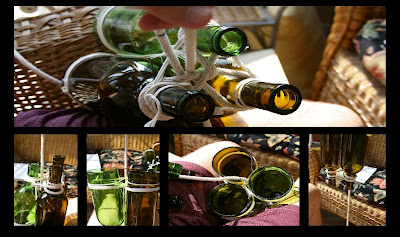So, as me and a friend were sitting around, lighting fires, breaking glass, he tossed out the idea that possibly bunching the plants together would work; making a horizontal, three plant 'platform' of sorts. As we thought about it, we quickly realized that it would be a fantastic way to squeeze a lot more bottles in the already condensed space of a window garden. And if I was able to find a simple way to hold it all together, it could be a lot more yield for a lot less work as well. Unlike the way the plastic bottles are cut and mounted in the traditional windowfarm, where a hole is cut in the side leaving a dome covering the back and blocking light, the wine bottles are cut clean, so they can be lined up evenly, and the sun still shines through.
The way I have made mine so far is pretty simple, I only used twine to tie together the bottles, a single, continuous piece of rope to hang all of them on. It certainly is not high-tech but, it works, was cheap, easy to assemble, and it is adjustable (it takes some getting used to, but after a little time working with it, it will become easy). The way I tie the three together is only four steps:
1. Tie a single strand around the middle, to hold the bottles in place whilst tying.
2. I usually start with the cut ends of the bottles. Following the top pattern for wrapping with twine, I usually repeated until I had three lengths at every point. Pulled as tight as possible. Then tied it off.
3. With the uncorked ends, I then follow the bottom pattern. I pull really tightly to cause the bottles to act as levers and tight the previously tied string. At this point you can remove the first strand around the middle.
4. Tie an anchoring string between the top and bottom strands, at all three 'joints'. Like this one:
After you have done that, three or more times, the next step is assembling the tower. The top bottles will be used as reservoirs, I have planned on using the large sized wine bottles for reservoirs, but have not gotten my hands on any as of yet. But if anybody has them on hand, I encourage to try using those, more volume is always better. I have made two tiers of plants in my current version, because that was all I had room for. I had an old coat rack lying around and figured, as is, or better yet with a little work, it is perfect for building a portable farm. On nice days when we are home, we have been moving it outside to get more direct light, then bringing it back in at night. It looks like this:
And this is a little tutorial on how to tie it. I tried to make it simple and straightforward like the other one (I am using rope that is approx. 1/4" diameter, rated to 100 lbs.):
This first part is showing how I measured out the rope. I mark at 2'10" in this, but that was a tad long, aim for 2'8".
These last two parts are showing how to tie the bottom, if done correctly, it forces the modules to rest vertically on the rope. The necks generally positioned in a good place over the next bottles.


Lastly, you need to add a guide string at the top. The pattern I use for the best stability and adjustability is depicted in this drawing. It should be positioned between the top string and the cut ends of the bottles. It keeps the module stable on the rope.

You may want to also run a second length of rope to prevent the bottles from spinning. So far as I can tell, there is no light blockage between the towers (except maybe at midday if they are outside in the summer {but then they would be drying out in that direct light anyway}). And it has been working great so far. I recently transplanted eight lettuce plants into the other three bottles. One of them dried out and died, because the bottle is too small for the 3" net pot, and I didn't really expect it to survive. But I am designing a way to use a 2" pot (which is only slightly too small for this particular bottle). Something to keep in mind is the size of your bottles on the inside when choosing which you want for a module, because it is more work than it is worth to disassemble and reassemble if you end up with one awkward sized bottle, like me. Here are some more pictures of my two biggest plants:














